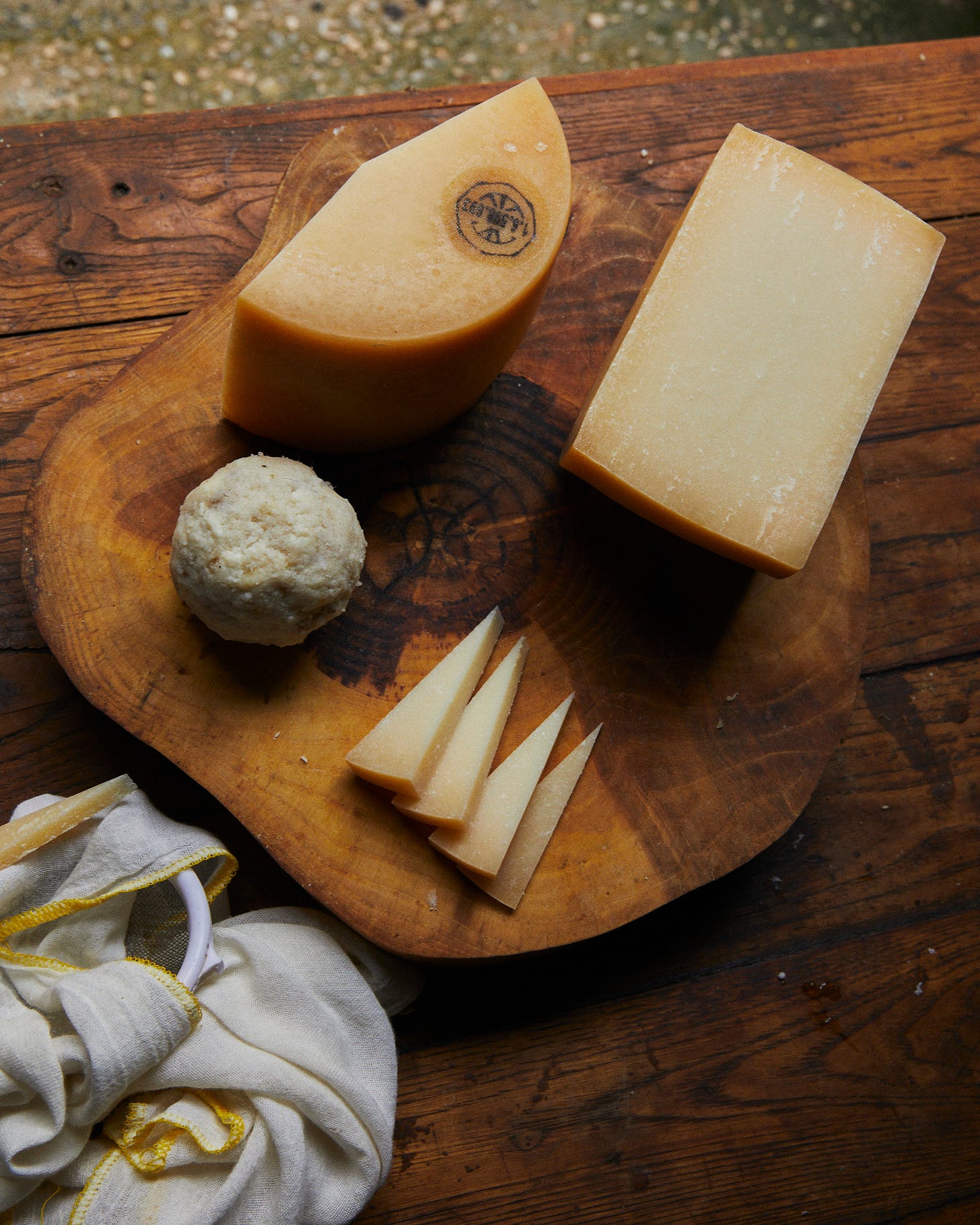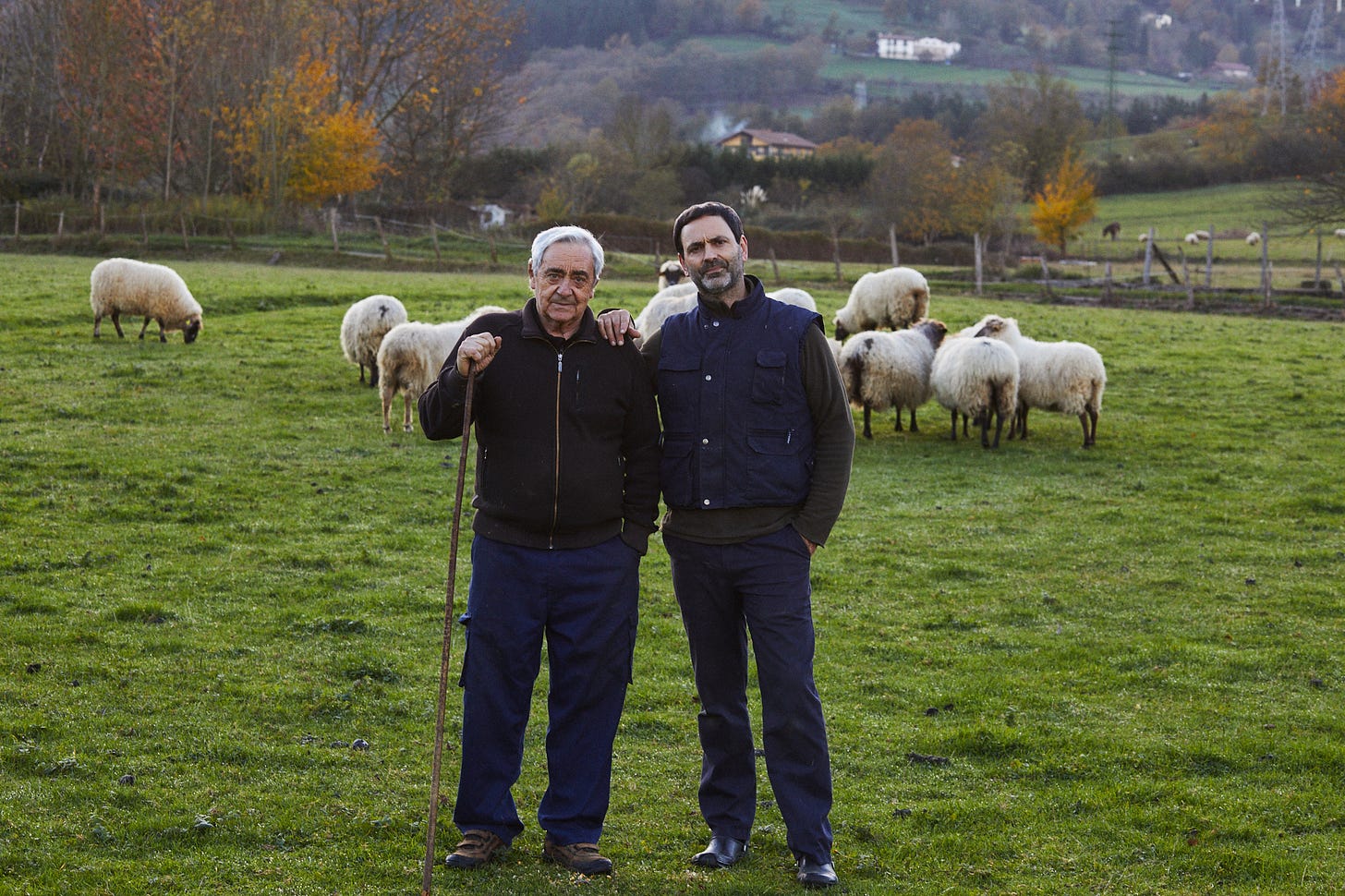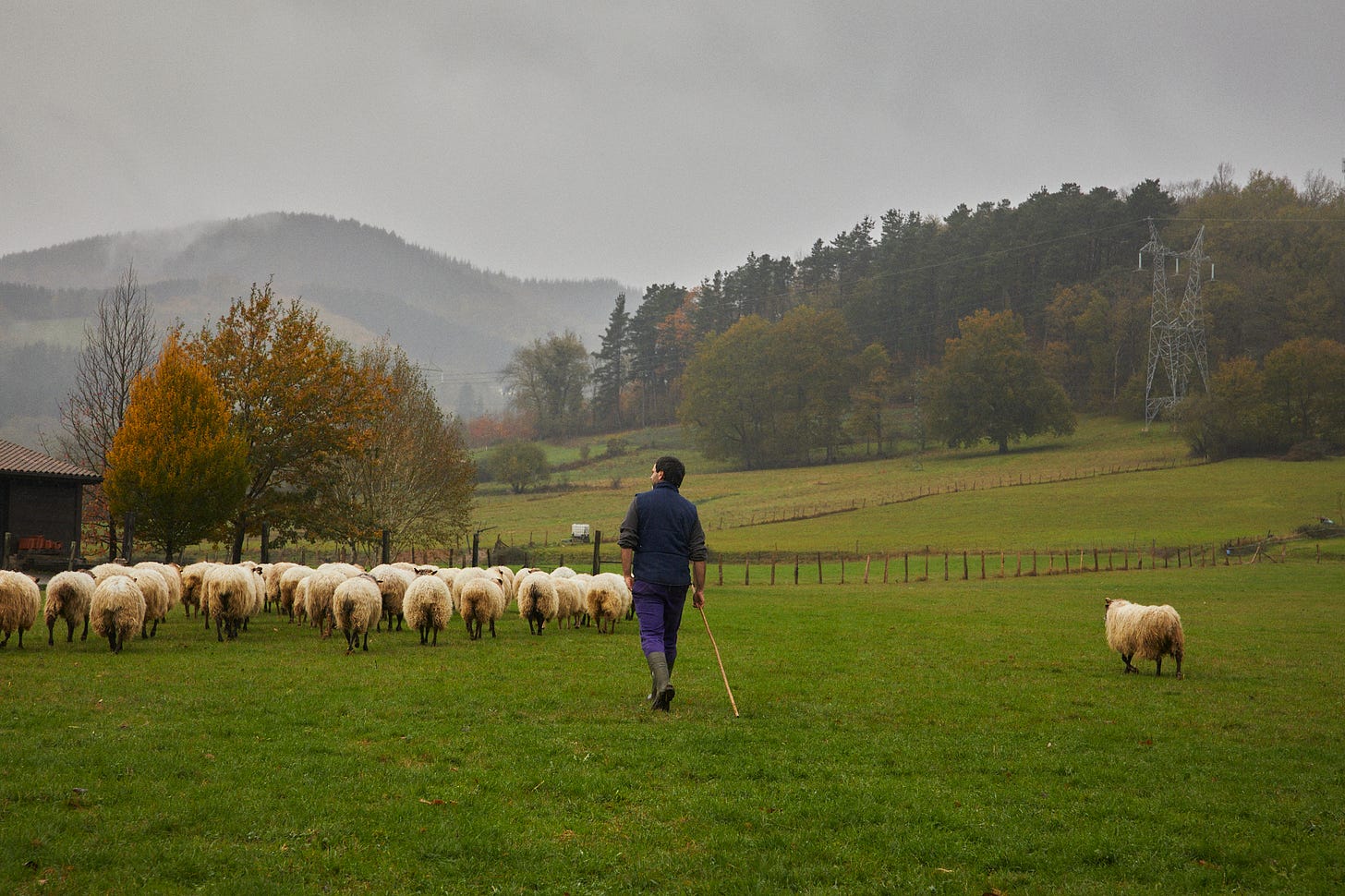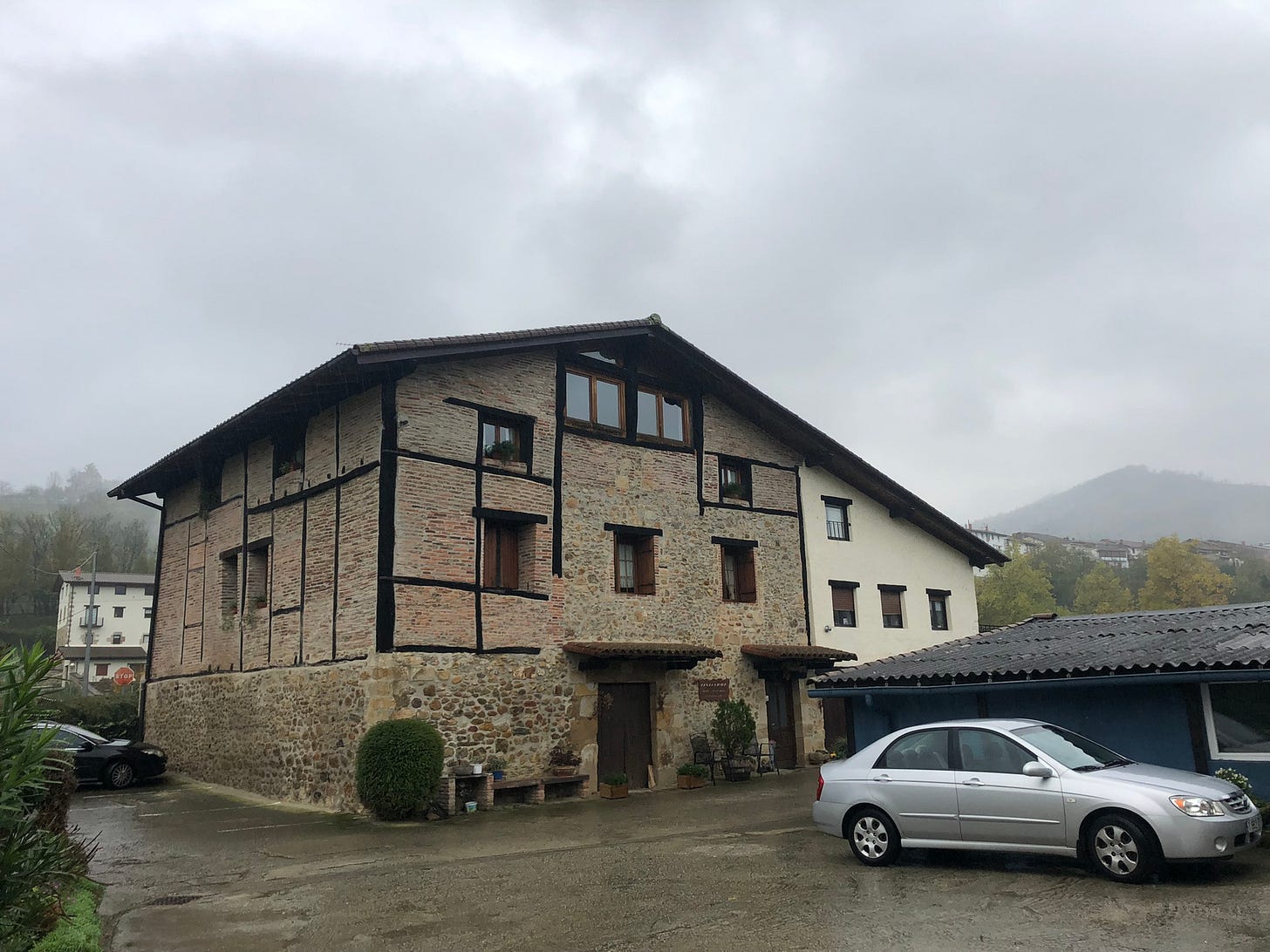The Basque: Idiazabal, the Latxa sheep, lamb rennet, and an old farmhouse
My return to learn more about the culture of sheep dairying.
Euskal Herria is the Basque name for their homeland, consisting of the 3 Spanish provinces in the Basque Autonomous Community, Navarra, and 3 provinces in France collectively known as the Northern Basque Country. From the coastal areas exposed to the North Atlantic with humid green hills, the climate transitions rapidly as one heads south through the Pyrenees. The landscape and weather remind me of southern Oregon, with mixed deciduous/coniferous forests bordering open pastures and orchards of apple, pear, and quince. The December air is saturated. Aromas of mushrooms and decomposing brambles along the edges of forests. Hardwood leaves make a colorful carpet extending out into green pastures that squish under the feet. I can barely make out the phantasmagoric white sheep, slowly moving behind a line of rotting fence posts, near the top of a hill, in the fog.
As I reflect on my travels, a theme has bubbled to the surface of the vat. It seems border regions and cultural/climatic transitional zones are often the places I find the practices and foods systems I seek. It’s not that these places are pre industrial promised lands, where the “traditional” still exists. But sometimes on the fringes of nation states, in the mountains, deserts, and less arable land, distinct cultural groups have held out against the empires, and traces of their pastoral customs remain, in modified form.
Evidence of a deep agricultural history are apparent in the Basque region of Gipuzkoa. Hedgerows and stone walls are still visible in places, and giant homes called baserri have been passed down through generations, each with a name that in the past was often used as the family title. These buildings formerly housed livestock in the bottom floor with humans living above, a pattern common in many countries. They are built of timber and stone, and like the Basque people, have an amazing ability to stand the test of time. Shifting, requiring renovation, but standing. We stayed in one near Segura called Ondarre that is 500 years old, with no end in site, even if the walls lean a bit in places
There is a deep link between Basque culture and shepherding, represented by a sheep breed that you see all over the region. The word Latxa means coarse or sufficient in the Basque language, referring to its wool. I am told this wool does a great job of shedding the rain, better than that of breeds such as Merino, whose fine wool is considered so desirable. Perhaps there is more Lanolin in this the coarse Latxa wool? There are a few major lines within the breed, black face and blond face. They are fairly small, and produce a low volume of milk, 95% of which is made into cheese. Idiazabal is the main cheese here, and it’s DO regulations stipulate that it be made with the milk of Latxa or Carranzana breed.
I came here a year ago, and was surprised to learn that some farmers still make their own rennet, from the lambs in their flocks. I met one such farmer, Eneko Goiburu, who showed me his frozen abomasums, which is the 4th compartment in the ruminant digestive system. He explained how he takes his 20-25 day old lambs to the slaughterhouse around Christmas, and gets the stomachs back. He hangs them, unsalted, to dry for a few weeks, and then freezes them whole. When he wants to make a month’s rennet paste, he cuts 4-5 open, cleans out most of the wool and any plant matter, cuts the skin of the stomach into bits, and mashs it all into a paste with salt.

This is a practice that the Idiazabal producers have fought to be allowed to continue. They were given an exemption to EU food safety laws somehow. But most of the makers do not take advantage, and use mainly liquid rennet made elsewhere, sometimes mixing in a bit of a whole stomach paste for flavor. Many still have their lambs taken to slaughter around Christmas when the price is high, at 10-12 kilos. But the abomasums are not utilized, which is unfortunate in my eyes
Eneko’s father made cheese using just the rennet paste made on the farm. This leads to a cheese that takes on fairly strong, piquant, spicy, savory flavors as it ages. These flavors can be found in many pecorinos from Sardinia and Sicily, or at low levels in Parmigiano. Apparently, this was the taste of Idiazabal until perhaps 30-40 years ago, when a transition towards a more tame, sweet cheese geared towards wider markets began. The makers started using less of the whole stomach rennet, and more liquid rennet, which lacks the enzymes that lead to the bold spicy flavors. Now even the remaining makers who make their own paste generally blend it with liquid rennet to get a more tame flavor. But is still has a rugged soul, and I honestly tend to prefer these blended ones, where the lipase doesn’t drown the range of flavors. Tradition doesn’t always equal best, it doesn’t always make sense, and adaptation to modernity is not necessarily negative.

I like returning to places I have visited before. Although only a year has passed, It feels like 5. I am changed, and feel older, and a bit weary. I can only imagine how the 500 year old house called Ondarre feels. It still stands, as it surely will after I am dead and gone. I came back to speak with Eneko again, to soak up a bit of his wisdom and energy. It was cold and rainy as we watched him put his sheep out to pasture. Eneko laments the loss of the old ways, with very few families now able to make a living from their farms. This self sufficiency was a point of pride for Basque farmer shepherds, rightfully so. He still performs antiquated methods, such as putting a notch in a specific part of each sheep’s ear, an old way of identifying a sheep as belonging to a particular house. The sheep all have the modern version, a yellow numbered ear tag, but Eneko maintains the older tradition for reasons that I don’t fully understand, but respect.
As someone from the west coast of America, where everyone is a relative newcomer, the depth of culture and history in places like this astound me. The sense of belonging to a place, to a landscape that your family has worked for many generations, is foreign to me. Cultural pride, and conservative longing to maintain the old ways can have its dark side, but it can also be an essential ingredient in keeping systems going that have been worked out by centuries of trial and error, of accumulated knowledge.
It’s a complex topic to take a firm stance on, so I don’t. I just walk on, observing and reflecting on the people I have met, the places I’ve seen. I find something inspiring and poetically beautiful in this 500 year old house. It’s not my home, but it is the epitome of what a home can be. It feels good to know I can return again someday, to this house that is not my home, but that welcomes me none the less, inside its leaning walls, that still stand, keeping out the cold and damp.
photo credit: Alexander Pomper











Thank you for sharing your journey and thoughts. There is a lot that can be said for these traditional methods - they are a foundation that inspired modern aspects known more today. Tradition also helps align one with a value system, a grounding that can be spiritual, nourishing dynamically. Continue to explore yourself while on this vast endeavor. Much love to you.
Good read, interesting points in terms of mixing the traditional with the new. Makes me feel hopeful about the world of acceptance and compromise. I am surprised about the wool in the stomachs?